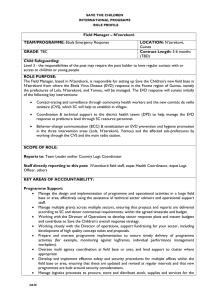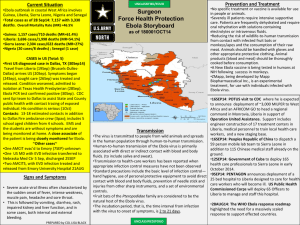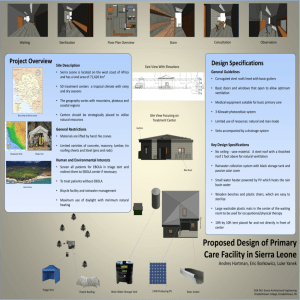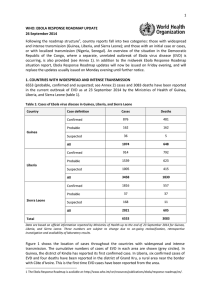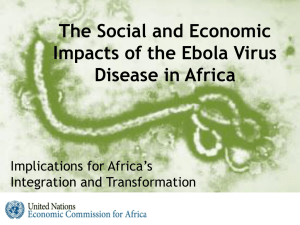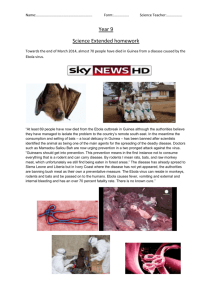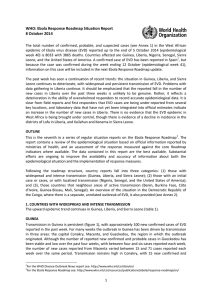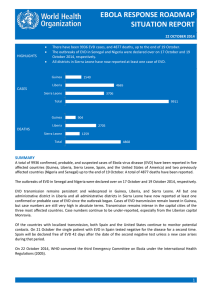EBOLA RESPONSE ROADMAP SITUATION REPORT UPDATE EBOLA RESPONSE ROADMAP SITUATION REPORT
advertisement
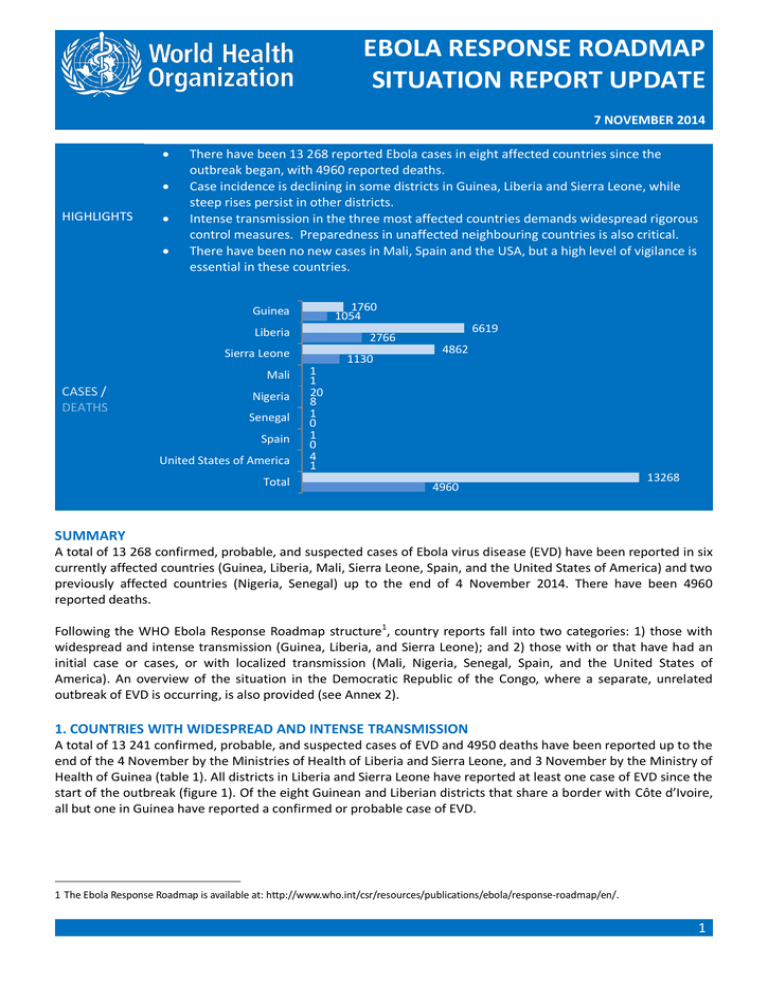
EBOLA RESPONSE ROADMAP ROADMAP SITUATION REPORT EBOLA RESPONSE SITUATION REPORT UPDATE 7 NOVEMBER 2014 HIGHLIGHTS There have been 13 268 reported Ebola cases in eight affected countries since the outbreak began, with 4960 reported deaths. Case incidence is declining in some districts in Guinea, Liberia and Sierra Leone, while steep rises persist in other districts. Intense transmission in the three most affected countries demands widespread rigorous control measures. Preparedness in unaffected neighbouring countries is also critical. There have been no new cases in Mali, Spain and the USA, but a high level of vigilance is essential in these countries. 1760 1054 Guinea Liberia Sierra Leone Mali CASES / DEATHS Nigeria Senegal Spain United States of America Total 6619 2766 1 1 20 8 1 0 1 0 4 1 1130 4862 4960 13268 SUMMARY A total of 13 268 confirmed, probable, and suspected cases of Ebola virus disease (EVD) have been reported in six currently affected countries (Guinea, Liberia, Mali, Sierra Leone, Spain, and the United States of America) and two previously affected countries (Nigeria, Senegal) up to the end of 4 November 2014. There have been 4960 reported deaths. Following the WHO Ebola Response Roadmap structure1, country reports fall into two categories: 1) those with widespread and intense transmission (Guinea, Liberia, and Sierra Leone); and 2) those with or that have had an initial case or cases, or with localized transmission (Mali, Nigeria, Senegal, Spain, and the United States of America). An overview of the situation in the Democratic Republic of the Congo, where a separate, unrelated outbreak of EVD is occurring, is also provided (see Annex 2). 1. COUNTRIES WITH WIDESPREAD AND INTENSE TRANSMISSION A total of 13 241 confirmed, probable, and suspected cases of EVD and 4950 deaths have been reported up to the end of the 4 November by the Ministries of Health of Liberia and Sierra Leone, and 3 November by the Ministry of Health of Guinea (table 1). All districts in Liberia and Sierra Leone have reported at least one case of EVD since the start of the outbreak (figure 1). Of the eight Guinean and Liberian districts that share a border with C te d voire, all but one in Guinea have reported a confirmed or probable case of EVD. 1 The Ebola Response Roadmap is available at: http://www.who.int/csr/resources/publications/ebola/response-roadmap/en/. 1 EBOLA RESPONSE ROADMAP SITUATION REPORT Table 1: Confirmed, probable, and suspected cases in Guinea, Liberia, and Sierra Leone Country Guinea Liberia Sierra Leone Case definition Cumulative Cases Cumulative Deaths Confirmed 1479 850 Probable 204 204 Suspected 77 0 All 1760 1054 Confirmed 2514 * Probable 1629 * Suspected 2476 * All 6619 2766 Confirmed 4149 921 Probable 79 174 Suspected 634 35 All 4862 1130 Total 13 241 4950 *N/A. Data are based on official information reported by the Ministries of Health of Liberia and Sierra Leone up to the end of 4 November, and the Ministry of Health of Guinea up to the end of 3 November. These numbers are subject to change due to ongoing reclassification, retrospective investigation and availability of laboratory results. A total of 549 health-care workers (HCWs) are known to have been infected with EVD up to the end of 4 November: 88 in Guinea; 318 in Liberia; 11 in Nigeria; 128 in Sierra Leone; 1 in Spain; and 3 in the United States of America (two were infected in the USA and one in Guinea). A total of 311 HCWs have died. WHO is undertaking extensive investigations to determine how each HCW became infected. Early indications are that a substantial proportion of infections have occurred outside the context of Ebola treatment and care. Infection prevention and control quality assurance checks are underway at Ebola treatment centres in the three intense-transmission countries. At the same time, exhaustive efforts are ongoing to ensure an ample supply of optimal personal protective equipment (PPE) to all Ebola treatment facilities, along with the provision of training and relevant guidelines to ensure that all HCWs are exposed to the minimum possible level of risk. WHO has moved more than 1 million sets of PPE to Guinea, Liberia and Sierra Leone, and continues to work with ministries of health and other partners to procure and distribute PPE where it is most needed. 2. COUNTRIES WITH AN INITIAL CASE OR CASES, OR WITH LOCALIZED TRANSMISSION Five countries (Mali, Nigeria, Senegal, Spain, and the United States of America) have now reported a case or cases imported from a country with widespread and intense transmission. n Nigeria, there were 20 cases and 8 deaths. n Senegal, there was 1 case and no deaths. However, following a successful response in both countries, the outbreaks of EVD in Senegal and Nigeria were declared over on 17 October and 19 October 2014, respectively. On 23 October, Mali reported its first confirmed case of EVD (table 2). The patient was a 2-year-old girl who travelled from Guinea with her grandmother to Mali. On 22 October the patient was admitted to Fousseyni Daou hospital in Kayes. She died on 24 October. Samples for laboratory confirmation were sent to SERAFO in Bamako and were positive for EVD. This has been confirmed by laboratory testing conducted by the US Centers for Disease Control and Prevention in Atlanta. To date, 108 contacts have been identified and are being followed up. 2 EBOLA RESPONSE ROADMAP SITUATION REPORT Figure 1: Geographical distribution of cases in the past 21 days and total cases in Guinea, Liberia, Mali and Sierra Leone Data are based on situation reports provided by countries. The boundaries and names shown and the designations used on this map do not imply the expression of any opinion whatsoever on the part of the World Health Organization concerning the legal status of any country, territory, city or area or of its authorities, or concerning the delimitation of its frontiers or boundaries. Dotted and dashed lines on maps represent approximate border lines for which there may not yet be full agreement. n Spain, a HCW infected during the care of an EVD-positive patient in Madrid tested negative for EVD on 19 October. A second negative test was obtained on 21 October. All 83 contacts of the HCW have completed the 21day follow-up period. Spain will therefore be declared free of EVD 42 days after the date of the second negative test if no new cases are reported. There have been 4 cases and 1 death in the United States of America. The most recent case is a medical aid worker who volunteered in Guinea and returned to New York City on 17 October. The patient was screened and was asymptomatic on arrival, but reported a fever on 23 October, and tested positive for EVD. The patient is currently in isolation at Bellevue Hospital in New York City, one of eight New York State hospitals that have been designated to treat patients with EVD. 3 EBOLA RESPONSE ROADMAP SITUATION REPORT Two HCWs who became infected after treating an EVD-positive patient at the Texas Presbyterian Hospital of Dallas, Texas, have twice tested negative for EVD and have been discharged from hospital. The last contact being monitored in connection with the 3 cases in Texas was expected to complete 21-day follow-up on 7 November. Of a total of 177 possible contacts in the USA, 16 are being monitored and 161 have completed the 21-day followup period. Table 2: Ebola virus disease cases and deaths in Mali, Spain, and the United States of America Country Case definition Cases Deaths Confirmed 1 1 Probable 0 0 Suspected 0 0 All 1 1 Confirmed 1 0 Probable 0 0 Suspected 0 0 All 1 0 Confirmed 4 1 Probable 0 0 Suspected 0 0 All 4* 1 6 2 Mali Spain United States of America Total *Includes two HCWs infected in the USA while treating an EVD-positive patient from Liberia, and a HCW infected in Guinea. Data are based on official information reported by Ministries of Health. These numbers are subject to change due to ongoing reclassification, retrospective investigation and availability of laboratory results. 4 EBOLA RESPONSE ROADMAP SITUATION REPORT ANNEX 1: CATEGORIES USED TO CLASSIFY EBOLA CASES Ebola cases are classified as suspected, probable, or confirmed depending on whether they meet certain criteria (table 3). Table 3: Ebola case-classification criteria Classification Criteria Suspected Any person, alive or dead, who has (or had) sudden onset of high fever and had contact with a suspected, probable or confirmed Ebola case, or a dead or sick animal OR any person with sudden onset of high fever and at least three of the following symptoms: headache, vomiting, anorexia/ loss of appetite, diarrhoea, lethargy, stomach pain, aching muscles or joints, difficulty swallowing, breathing difficulties, or hiccup; or any person with unexplained bleeding OR any sudden, unexplained death. Probable Any suspected case evaluated by a clinician OR any person who died from ‘suspected Ebola and had an epidemiological link to a confirmed case but was not tested and did not have laboratory confirmation of the disease. Confirmed A probable or suspected case is classified as confirmed when a sample from that person tests positive for Ebola virus in the laboratory. ANNEX 2: EBOLA OUTBREAK IN DEMOCRATIC REPUBLIC OF THE CONGO As of 3 November 2014, there have been 66 cases (38 confirmed, 28 probable) of Ebola virus disease (EVD) reported in the Democratic Republic of the Congo, including eight among health-care workers (HCWs). In total, 49 deaths have been reported, including eight among HCWs. All suspected cases have now been discarded. No new reported contacts are being followed. Twenty-seven days have passed since the last official case tested negative for the second time and was discharged from hospital. The Democratic Republic of the Congo will therefore be declared free of EVD 42 days after the date of the second negative test if no new cases are reported. This outbreak is unrelated to the outbreak that originated in West Africa. 5
